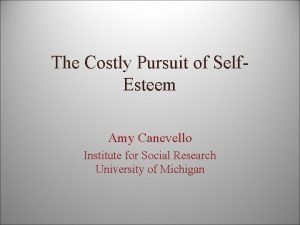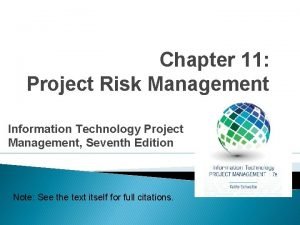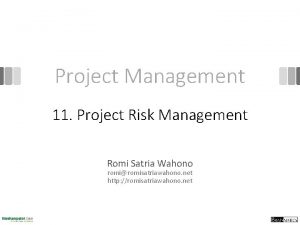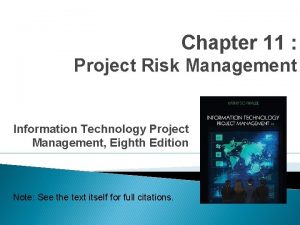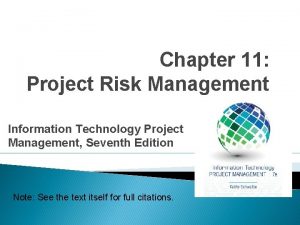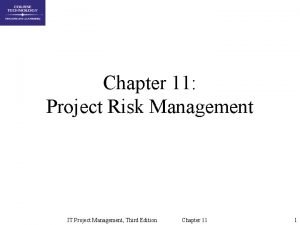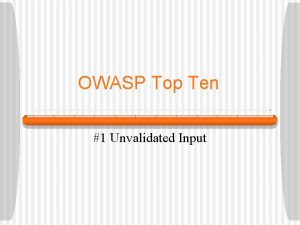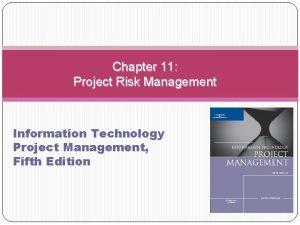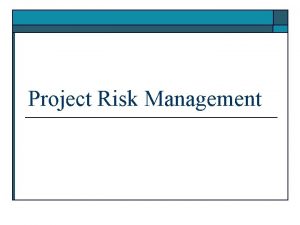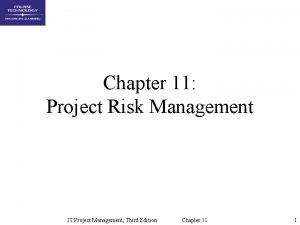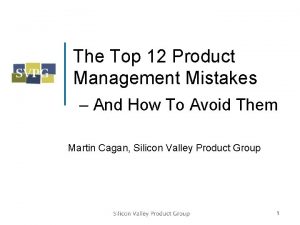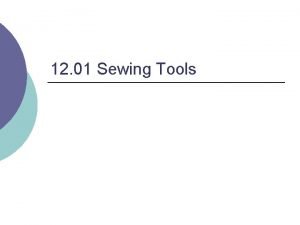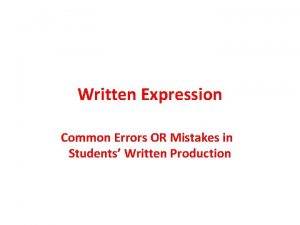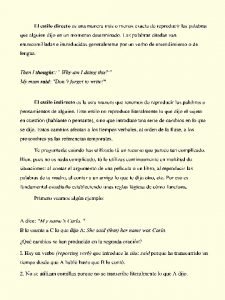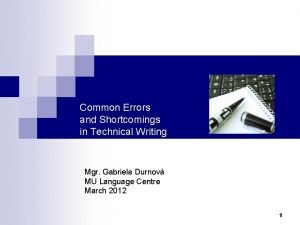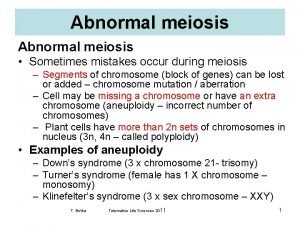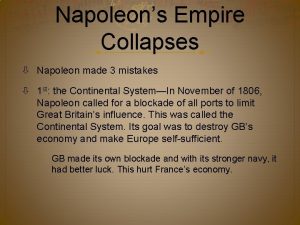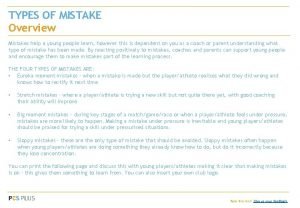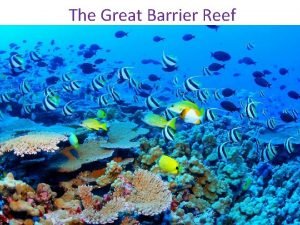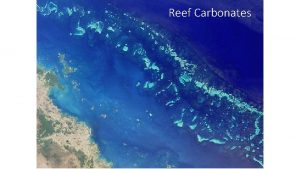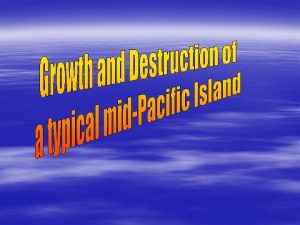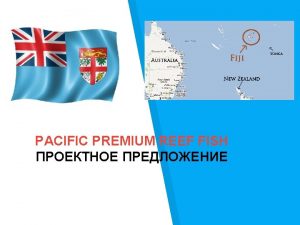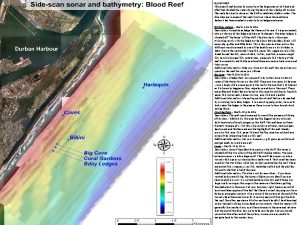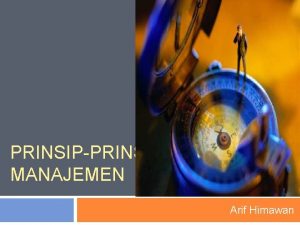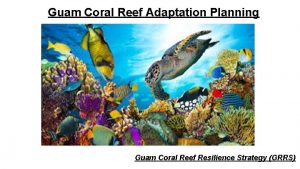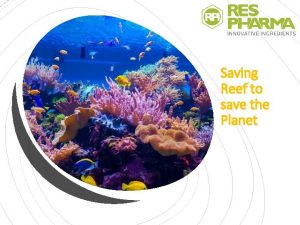Reef Keeping n Top ten most costly mistakes































































- Slides: 63

Reef Keeping

n. Top ten most costly mistakes

n If you decide to make a salt water aquarium it can be a little intimidating


review 96. 5% water n 3. 5% salt by weight n Even ions at low concentration are important to ocean organisms n With the salts comes water changes…density, conductivity, and refractive index n


n The index of refraction (or refractive index) is the ratio of the speed of light traveling through a vacuum to the speed of light in the material being tested. Most aquarists do not realize that when using a refractometer, they are measuring the speed of light through their aquarium's water, so having such knowledge might be a good way to impress friends with your technical abilities!

n Light travels through most materials more slowly than it does through a vacuum, so their refractive index is higher than 1. 00000. The detailed mathematics and physics behind refractive index are actually quite complicated, because it is often a complex number with real and imaginary parts, but a simple version is adequate for all purposes that a reef aquarist would encounter. Some materials slow light traveling through them more than others, and slower light travel leads to a higher refractive index. Table 1 shows some typical refractive index values for comparative purposes.

n n n n Table 1. Index of Refraction of Various Materials. Vacuum 1. 0000 Air 1. 0003 Water (pure)1. 3330 Seawater (35 ppt)1. 3394 Ethyl alcohol 1. 361 Sugar solution (80% sugar)1. 49 Glass (soda lime)1. 510

In solutions of two compounds, such as ethyl alcohol in water, sugar in water or salt in water, the refractive index changes in step with how much of each component is present. n refractometers are used in brewing, sugar refining, analyzing blood and urine protein and many other industries where a quick measure of refractive index can lead to a good assessment of what is present. n

n It cannot tell you what the molecule is but it can give you an idea of how much

Price range refractometer 100 -200 dollars n Aquarists can use the effects that added salts have on the refractive index of a water solution to determine the salinity of reef aquarium water. As the salinity of seawater rises, the amount of salt added rises, so the refractive index rises.



Conductivity n How well electrons move through the water…or how well electricity moves through the water Na. Cl density (W / V) % Conductivity (m. S / cm) 0. 1 2. 0 1. 1 19. 2 0. 2 3. 9 1. 2 20. 8 0. 3 5. 7 1. 3 22. 4 0. 4 7. 5 1. 4 24. 0 0. 5 9. 2 1. 5 25. 6 0. 6 10. 9 1. 6 27. 1 0. 7 12. 6 1. 7 28. 6 0. 8 14. 3 1. 8 30. 1 0. 9 16. 0 1. 9 31. 6 1. 0 17. 6 2. 0 33. 0

Refractive index, conductivity, and density can all be used by someone keeping a reef (aquarium) to test for salinity.

90 -600 dollars

4 Main Ions Chloride n Sodium n Sulfate n magnesium n

Natural Seawater for a reef Collect it yourself but important factors …how pure it was at collection and how pure it remained until use. n Collect the water offshore to avoid runoff n Or collect from a rising tide n Coastal waters have a lot of chemicals and pathogens n


If natural seawater is stored too long and it stagnates. …. . the break down of organic molecules can produce toxic substances. n It is better to use immediately n

Artificial Seawater It is probably ok just to use the cheapest you can get in a salt mix for an aquarium n Do not use sea salt for cooking it is usually to low in magnesium n It is hard to match the concentration of the less common ions in a salt mix n Everyone has their own opinion about which salt mix is best n

Prices range 25 -115 dollars In order to add the most common ions to water It takes a lot of material. Unless they are in pure (very expensive) form they will put a lot of impurities in the water. n

To be honest, the evidence for using one salt mix over another is marginal at best. Certainly some are better, and some may be bad, but no simple ranking can be made. Every artificial salt mix varies from natural seawater's concentrations of some ions. n many that claim to try to match seawater actually do a surprisingly poor job, and differ alot. n

n More expensive salt mixes can theoretically do a better job by purchasing purer raw materials, but that does not ensure that those companies do so.

matching natural seawater, is the problem. None really does, and it becomes very difficult to decide what is best. n For example, is it better to have too much sulfate or too little fluoride? n Too much strontium or too little potassium? No one knows. Ask that question about nearly every chemical constituent, and the true answer is, “No one knows n

So which to use n It is probably best to ask people that have made successful tanks before……In a poll I have taken 9 people used instant ocean and 7 used Reef Crystals and the rest were divided up into 1 person each with a different brand

Pure Water In addition to using a suitable salt mix, it is important to use suitably pure freshwater, both for making salt mixes and for topping-off for evaporative losses. .

n The majority of experienced and successful reef aquarists in the U. S. appear to use RO/DI (reverse osmosis/deionization) to purify tap water.



Prices range 100 -300 dollars n Reverse osmosis (RO) alone may be adequate in some cases, but not always.

n n n The use of tap water itself entails a number of concerns besides the presence of chlorine. First is Chloramines which does not dissipate after sitting around, the way many aquarists have done in the past for chlorine. It is now being added to many water supplies, and is much longer lived than chlorine. It also requires special treatments, not just the standard dechlorinating agents. Other concerns with tap water are copper (which often comes from your home's plumbing), nutrients (nitrate and phosphate) and alkalinity (which is not per se a problem, but can boost levels too high in some cases). .

n Chloramines can be removed by means of a granular active carbon filter

Chloramine (monochloramine) is a chemical compound with the formula NH 2 Cl. It is usually used as a dilute solution where it is used as a disinfectant. n Chlorine combines with ammonia n

n In general, I recommend avoiding tap water. Sure, some folks use it and have fine aquaria. Just safer in the long run.

n Typical commercial distilled water is likely acceptable, as long as it has not been exposed to metals such as copper in condensers, pipes or holding tanks. Unfortunately, it is not easy to know the production history of distilled water, and testing with most copper test kits may be inadequate because they may not accurately read low enough to detect its presence.

n Many aquarists use water provided by machines at grocery stores or from their local fish stores. Many of these are apparently reverse osmosis (RO) water.


review n natural ocean water has an average salinity of about 35 ppt, corresponding to a specific gravity of about 1. 0264 and a conductivity of 53 m. S/cm. Salinity can vary substantially from place to place.

n As far as I know, little real evidence suggests that keeping a coral reef aquarium at anything other than natural salinity levels is preferable.

n It appears to be common practice to keep marine fish, and in many cases reef aquaria, at somewhat lower than natural salinity levels. This practice stems, at least in part, from the belief that fish are less stressed at reduced salinity.

n Substantial misunderstandings also arise among aquarists as to how specific gravity really relates to salinity, especially considering temperature effects.

Specific gravity versus slainity n One question that every marine aquarist faces is the amount of salt to add to the tank. Most beginning texts choose to describe the salinity in terms of specific gravity, and go on to relate how one measures it with a hydrometer. While not nearly as precise as measuring salinity with a conductivity probe or a refractometer, hydrometers are chosen by many because they are inexpensive and easy to use.

Hydrometer measures density or specific gravity n For many aquarium purposes, they are perfectly adequate.

The wonderful world of spcific gravity n One question that every marine aquarist faces is the amount of salt to add to the tank. Most beginning texts choose to describe the salinity in terms of specific gravity, and go on to relate how one measures it with a hydrometer.

n While not nearly as precise as measuring salinity with a conductivity probe or a refractometer, hydrometers are chosen by many because they are inexpensive and easy to use. For many aquarium purposes, they are perfectly adequate.

n Why is specific gravity useful to aquarists? Primarily because it is a simple and quantitative way to tell how much of something is in water. If things less dense than water are dissolved in it, then the specific gravity will drop. Ethanol, for example, is less dense than water, and makes the specific gravity drop. This fact is used by brewers to gauge the amount of alcohol in their brews.

n Likewise, if things denser than water are dissolved in it, the specific gravity goes up. Nearly all inorganic salts are denser than water, so dissolving them in water makes the specific gravity rise. This rise can be used by aquarists to gauge how much salt is in their water. Of course, it cannot tell you what is in the water, but if you are using an appropriate salt mix, it can tell you how much is there and whether it approximates natural seawater or not.

n The salinity on natural reefs has been discussed in previous articles. My recommendation is to maintain salinity at a natural level. If the organisms in the aquarium are from brackish environments with lower salinity, or from the Red Sea with higher salinity, selecting something other than 35 ppt may make good sense. Otherwise, I suggest targeting a salinity of 35 ppt (specific gravity = 1. 0264; conductivity = 53 m. S/cm).

n Fortunately, coral reef aquaria seem rather forgiving with respect to salinity. The range of salinities in what most would say are successful reef aquaria is actually quite large. Don’t agonize over small changes from natural seawater. You will notice any benefit changing from 36 or 34 ppt to 35 ppt (specific gravity = 1. 0256 to 1. 0271). Many fine reef aquaria appear to run at salinity levels as low as 31 ppt (specific gravity = 1. 023), but bear in mind that the values that aquarists report (as well as your own measurements) are fairly likely to be inaccurate, so pushing the low or high end of the range may not be prudent.

n Bear in mind that if aquarists target salinity values different than 35 ppt, the amounts of calcium, magnesium, alkalinity, etc. , will all likely deviate from natural levels as well. For example, making artificial seawater to a low salinity will normally result in low values for these parameters and may require adjustments.

How to Mix Artificial Seawater n First, add the freshwater to the mixing container. The container can be any size, but larger containers will be less likely to have “off” parameters caused by taking a small portion of a container of salt mix that may not be representative of the bucket or bag due to settling.

n I make up 88 gallons at a time. Assuming that it is made from pure freshwater, mixed artificial seawater can be stored for as long as needed without continuous stirring or heating. I keep mine for a few weeks completely unstirred after initial mixing. It will not become anaerobic (although used tank water or natural seawater may become anaerobic due to the breakdown of organics in it, and should not be stored unaerated).

n Do not add anything other than salt mix to the freshwater unless you determine, after mixing in the salt, that it is deficient in something important. Add the salt and stir. Adding the salt before the water can be okay, but causes an unusually high salinity for the period when you are adding water, which can result in the formation of certain precipitates that may be hard to redissolve.

n Overnight stirring with a powerhead is a good way to dissolve the salt, but shorter stirring can be okay, if done vigorously. If you are using the saltwater for very small water changes (2% or less at once), you need not heat it. If you want to add any calcium (I do), magnesium (I do), alkalinity (I don’t) or anything else (not recommended), add it after the salt has dissolved. The overnight stirring will also help with aeration, which can be useful for some mixes that start with a high p. H and need to pull in CO 2 from the air to reach normal p. H.

n After aeration, the p. H is determined only by the alkalinity and the ambient carbon dioxide level in the air. It is not an attribute of the salt mix. More details on p. H will be covered in a future article. Aeration also pulls in oxygen, if the starting freshwater was deficient in oxygen.

n Measure the salinity, and then adjust it by adding more salt mix or more water as necessary to reach your desired salinity.

he following guidelines provide a short synopsis of the important conclusions from this article: n 1. Don’t focus on perfect salt mixes (none exist), or any other chemical attribute of coral reef aquaria. Focus on attainable suitability. n 2. Natural seawater might be a fine choice for a coral reef aquarium. If using natural seawater, be sure it is collected, treated and stored in a suitable manner. n

n 3. Artificial seawater is another option. Don’t get worked up by every salt mix comparison that comes along.

n A variety of brands of salt mix have been used successfully by a large number of aquarists, including Reef Crystals, Instant Ocean and Tropic Marin (Pro and regular). If you select one of these, it is unlikely that any failures you will encounter will relate to a problem with the salt mix.

4. Use appropriately pure freshwater to make the salt mix and top-off for evaporation. n 5. Use an appropriate device, appropriately calibrated, to measure salinity. I recommend targeting natural ocean salinity (S=35 PSU or 35 ppt, specific gravity = 1. 0264). But salinity is fairly forgiving, and a range around these values is certainly acceptable. n

conclusion n n Good water need not require an overly complicated exploration of chemical and biological testing. Asking questions from experienced people is the best bet. Using that type of information, this article provides the basics necessary to obtain suitable aquarium water to start with. Of course, that water quickly becomes depleted in some chemicals, and polluted with others. Subsequent articles in this series will provide details on how to deal with those issues in ways that are tried and true, and not overly complicated.
 Napoleons mistakes
Napoleons mistakes Owasp
Owasp Assignment on entrepreneurship development
Assignment on entrepreneurship development Top 10 mistakes pastors make
Top 10 mistakes pastors make Top 10 mistakes leaders make
Top 10 mistakes leaders make Top 10 mistakes in web design
Top 10 mistakes in web design David wants to buy a christmas present
David wants to buy a christmas present Degrees of comparison for bad
Degrees of comparison for bad Costly
Costly Amy canevello
Amy canevello Am i a 10/10
Am i a 10/10 Twenty past two
Twenty past two Ten ten siempre fuerzas y esperanza
Ten ten siempre fuerzas y esperanza Top ten risk item tracking
Top ten risk item tracking Owasp mobile top ten
Owasp mobile top ten Paloasetus
Paloasetus Elasmobranchologist
Elasmobranchologist Top ten risk item tracking
Top ten risk item tracking Top ten risk item tracking
Top ten risk item tracking Top ten risk item tracking
Top ten risk item tracking Figure 11-4
Figure 11-4 Top ten tips
Top ten tips Top 10 sins
Top 10 sins Unvalidated input
Unvalidated input Owasp top 10 2013
Owasp top 10 2013 Expected monetary value
Expected monetary value Top ten risk item tracking
Top ten risk item tracking Top ten risk item tracking
Top ten risk item tracking Top ten mathematics
Top ten mathematics Top ten risk item tracking
Top ten risk item tracking Paragraph about office work
Paragraph about office work Napoleon 3 mistakes
Napoleon 3 mistakes Biggest mistakes product management
Biggest mistakes product management The man makes all the following mistakes except
The man makes all the following mistakes except Heavy duty cutting of fabric
Heavy duty cutting of fabric Annuity mistakes to avoid
Annuity mistakes to avoid Computer waste and mistakes
Computer waste and mistakes Example of error and mistake
Example of error and mistake Scientific mistakes in the bible
Scientific mistakes in the bible Rewrite the statements as reported speech
Rewrite the statements as reported speech Swompt
Swompt Find six mistakes in robin's spelling test
Find six mistakes in robin's spelling test Revolt of the earls
Revolt of the earls 10 common comunication mistakes
10 common comunication mistakes Spot mr whoops mistakes answers
Spot mr whoops mistakes answers Mistakes in meiosis
Mistakes in meiosis Mistakes images
Mistakes images Power bi mistakes to avoid online courses
Power bi mistakes to avoid online courses Alfred adler theory
Alfred adler theory Mistakes are the portals of discovery meaning
Mistakes are the portals of discovery meaning Linear surveying
Linear surveying Look and find the mistakes
Look and find the mistakes We all make mistakes
We all make mistakes Napoleons 3 mistakes
Napoleons 3 mistakes Mistake types
Mistake types Data warehouse optimization mistakes
Data warehouse optimization mistakes Songs with alliteration clean
Songs with alliteration clean Syntactic mistakes
Syntactic mistakes Harolds mistakes in the battle of hastings
Harolds mistakes in the battle of hastings Proverbs about learning from mistakes
Proverbs about learning from mistakes Present simple positive
Present simple positive Types of mistakes
Types of mistakes A computer makes mistakes true or false
A computer makes mistakes true or false Common algebra mistakes
Common algebra mistakes









